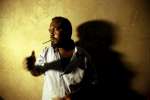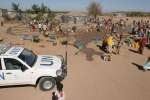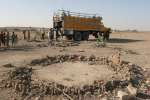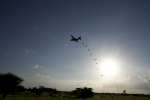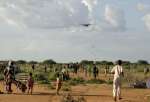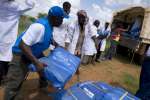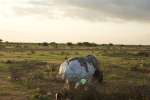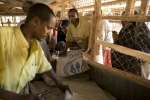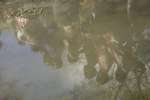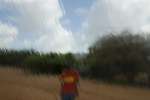UNHCR deeply regrets killing of a Somali refugee leader in Dadaab
Press Releases, 30 December 2011
GENEVA – The United Nations High Commissioner for Refugees, António Guterres, voiced today his deep regrets about the senseless killing of a refugee leader in the Dadaab refugee complex in northern Kenya yesterday evening (Thursday 29 December).
The chairperson of the Community Peace and Security Team in Hagadera camp was shot as he was entering his compound around 19:45 Thursday evening. The refugee-run Community Peace and Security teams are instrumental in helping maintain security in the camps.
The victim was shot several times and the gunmen reportedly escaped. The shooting was immediately reported to the local police. Refugees rushed him to the hospital in Hagadera camp. Despite all efforts he passed away early this morning while being evacuated to Nairobi.
Dadaab is the world's largest refugee settlement and shelters more than 460,000 people. Somalia remains one of the worst humanitarian crises in the world. More than 950,000 Somalis live as refugees in neighbouring countries while another 1.46 million are internally displaced.
Contacts:
- In Nairobi: Vivian Tan: +254 735 337608
- In Geneva: Andrej Mahecic: +41 792007617
Crossing the Gulf of Aden
Every year thousands of people in the Horn of Africa - mainly Somalis and Ethiopians - leave their homes out of fear or pure despair, in search of safety or a better life. They make their way over dangerous Somali roads to Bossaso in the northern semi-autonomous region of Puntland.
In this lawless area, smuggler networks have free reign and innocent and desperate civilians pay up to US$150 to make the perilous trip across the Gulf of Aden.
Some stay weeks on end in safe houses or temporary homes in Bossaso before they can depart. A sudden call and a departure in the middle of the night, crammed in small unstable boats. At sea, anything can happen to them - they are at the whim of smugglers. Some people get beaten, stabbed, killed and thrown overboard. Others drown before arriving on the beaches of Yemen, which have become the burial ground for hundreds who many of those who died en route.
Crossing the Gulf of Aden
Somalia/Ethiopia
In February 2005, one of the last groups of Somalilander refugees to leave Aisha refugee camp in eastern Ethiopia boarded a UNHCR convoy and headed home to Harrirad in North-west Somalia - the self-declared independent state of Somaliland. Two years ago Harrirad was a tiny, sleepy village with only 67 buildings, but today more than 1,000 people live there, nearly all of whom are former refugees rebuilding their lives.
As the refugees flow back into Somalia, UNHCR plans to close Aisha camp by the middle of the year. The few remaining refugees in Aisha - who come from southern Somalia - will most likely be moved to the last eastern camp, Kebribeyah, already home to more than 10,000 refugees who cannot go home to Mogadishu and other areas in southern Somalia because of continuing lawlessness there. So far refugees have been returning to only two areas of the country - Somaliland and Puntland in the north-east.
Somalia/Ethiopia
Flood Airdrop in Kenya
Over the weekend, UNHCR with the help of the US military began an emergency airdrop of some 200 tonnes of relief supplies for thousands of refugees badly hit by massive flooding in the Dadaab refugee camps in northern Kenya.
In a spectacular sight, 16 tonnes of plastic sheeting, mosquito nets, tents and blankets, were dropped on each run from the C-130 transport plane onto a site cleared of animals and people. Refugees loaded the supplies on trucks to take to the camps.
Dadaab, a three-camp complex hosting some 160,000 refugees, mainly from Somalia, has been cut off from the world for a month by heavy rains that washed away the road connecting the remote camps to the Kenyan capital, Nairobi. Air transport is the only way to get supplies into the camps.
UNHCR has moved 7,000 refugees from Ifo camp, worst affected by the flooding, to Hagadera camp, some 20 km away. A further 7,000 refugees have been moved to higher ground at a new site, called Ifo 2.
Posted in December 2006
Flood Airdrop in Kenya


Brighter Lives for Refugees
Thanks to IKEA Foundation's support, UNHCR is helping improve access to lighting, renewable energy solutions and primary education in refugee camps in parts of Asia, Africa and the Middle East.


Return to Somalia
Ali and his family are ready to return to Somalia after living in Dadaab refugee camp for the past five years. We follow their journey from packing up their home in the camp to settling into their new life back in Somalia.


Kenya: High Commissioner Visits Dadaab Refugee Camp
Last week the UN High Commissioner for Refugees, António Guterres completed a visit to Kenya and Somalia where he met with the Presidents of the two countries, as well as Somali refugees and returnees.








